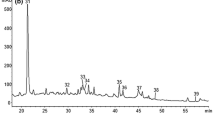Abstract
Benzoic acid, total anthocyanins, soluble solids, titratable acidity, and colour properties in juice of the American cranberry Vaccinium macrocarpon and the European cranberry Vaccinium oxycoccos were investigated. Berry juices of V. macrocarpon cultivars were distinguished by their higher total anthocyanin and benzoic acid amounts. These cultivars accumulated on average 43.11 mg/l of benzoic acid and 92.45 mg/l of total anthocyanins. The levels of benzoic acid and total anthocyanins in V. oxycoccos cultivars were 17.52 mg/l and 42.54 mg/l, respectively. The V. macrocarpon cultivars ‘Franklin’, ‘Le Munyon’, ‘Searles’, and ‘Early Richard’ were selected as the best according to the enhanced total anthocyanins and benzoic acid amounts. The separation of anthocyanins by HPLC-UV-VIS revealed the presence of six anthocyanins, with peonidin-3-galactoside being the most prevalent. Galactoside together with glucoside conjugates comprised the largest percentage of total anthocyanins in the juices of V. macrocarpon and V. oxycoccos cultivars.

Similar content being viewed by others
References
Paredes-López O, Cervantes-Ceja ML, Vigna-Pérez M, Hernández-Pérez T (2010) Berries: Improving human health and healthy aging, and promoting quality life—a review. Plant Foods Hum Nutr 65:299–308
Djordjević B, Šavikin K, Zdunić G, Janković G, Vulić T, Oparnica Č, Radivojević D (2010) Biochemical properties of red currant varieties in relation to storage. Plant Foods Hum Nutr 65:326–332
Egea I, Sánchez-Bel P, Romojaro F, Pretel MT (2010) Six edible wild fruits as potential antioxidants additives or nutritional supplements. Plant Foods Hum Nutr 65:121–129
Chen H, Zuo Y, Deng Y (2001) Separation and determination of flavonoids and other phenolics compounds in cranberry juice by high-performance liquid chromatography. J Chromatogr A 913:387–395
Taruscio TG, Barney DL, Exon J (2004) Content and profile of flavanoid and phenolic acid compounds in conjunction with the antioxidant capacity variety of Northwest Vaccinium berries. J Agric Food Chem 52:3169–3176
Ursini F, Tubaro F, Rong J, Sevanian A (1999) Optimization of nutrition: Polyphenols and vascular protection. Nutr Rev 57:241–249
Szajdek A, Borowska EJ (2008) Bioactive compounds and health-promoting properties of berry fruits: A review. Plant Foods Hum Nutr 63:147–156
Cavanagh HM, Hipwell M, Wilkinson JM (2003) Antibacterial activity of berry fruits used for culinary purposes. J Med Food 6:57–61
Leitao DP, Polizello AC, Ito IY, Spadaro AC (2005) Antibacterial screening of anthocyanic and proanthocyanic fractions from cranberry juice. J Med Food 8:36–40
Sun J, Liu RH (2006) Cranberry phytochemical extracts induce cell cycle arrest and apoptosis in human MCF-7 breast cancer cells. Cancer Lett 241:124–134
Wilson T, Porcari JP, Harbin D (1998) Cranberry extract inhibits low density lipoprotein oxidation. Life Sci 62:PL381–PL386
Liu Y, Black MA, Caron L, Camesano TA (2006) Role of cranberry juice on molecular-scale surface characteristics and adhesion behavior of Escherichia coli. Biotechnol Bioeng 93:297–305
Labrecque J, Bodet C, Chandad F, Grenier D (2006) Effects of a high-molecular-weight cranberry fraction on growth, biofilm formation and adherence of Porphyromonas gingivalis. J Antimicrob Chemother 58:439–443
Yamanaka A, Kimizuka R, Kato T, Okuda K (2004) Inhibitory effects of cranberry juice on attachment of oral streptococci and biofilm formation. Oral Microbiol Immunol 19:150–154
Makeev VA, Cherkassov AF, Makeeva GY (2000) Results and future outlook for Oxycoccus palustris selection. In: Proceedings of the International Conference: Problems of Rational Utilization and Reproduction of Berry Plants in Boreal Forests on the Eve of the XXI Century, Belarus, Glubokoye-Gomel, September 11–15, pp 178–180.
Česonienė L, Jasutienė I, Šarkinas A (2009) Phenolics and anthocyanins in berries of European cranberry and their antimicrobial activity. Med Lith 45(12):992–999
Huopalahti R, Järvenpää EP, Katina K (2000) Novel solid-phase extraction-HPLC method for the analysis of anthocyanin and organic acid composition of Finnish cranberry. J Liq Chrom Relat Tech 23(17):2695–2701
Puupponen-Pimiä R, Nohynek L, Alakomi HL, Oksman-Caldentey KM (2005) Bioactive berry compounds—Novel tools against human pathogen. Appl Microbiol Biotechnol 67:8–18
Vorsa N, Polashock JJ (2005) Alteration of anthocyanin glycosylation in cranberry through interspecific hybridization. J Am Soc Hortic Sci 130(5):711–715
Viskelis P, Rubinskienė M, Jasutienė I, Šarkinas A, Daubaras R, Česonienė L (2009) Anthocyanins, antioxidative, and antimicrobial properties of American cranberry (Vaccinium macrocarpon Ait) and their press cakes. J Food Sci 74(2):C157–C161
Wrolstad RE (1976) Colour and pigment analyses in fruit products. Agricultural Experiment Station Bulletin 624, Oregon State University.
Rubinskiene M, Jasutiene I, Venskutonis PR, Viskelis P (2005) HPLC determination of the composition and stability of blackcurrant anthocyanins. J Chromatogr Sci 43(9):478–482
McGuiere RG (1992) Reporting of objective colour measurements. HortScience 27(12):1254–1255
Sapers GM, Hargrave DL (1987) Proportions of individual anthocyanins in fruits of cranberry cultivars. J Am Soc Hortic Sci 112(1):100–104
Andersen ØM (1989) Anthocyanins in fruits of Vaccinium oxycoccus L. (small cranberry). J Food Sci 54(2):383–384
Monagas M, Núñez V, Bartolomé B, Gómez-Cordovés C (2003) Anthocyanin-derived pigments in Graciano, Tempranillo, and Cabernet Sauvignon wines produced in Spain. Am J Enol Viticult 54(3):163–169
Willamor RR, Harbertson JF, Ross C (2009) Influence of tannin concentration, storage temperature, and time on chemical and sensory properties of Cabernet Sauvignon and Merlot wines. Am J Enol Viticult 60(4):442–449
Yue X, Xu Z (2008) Changes of anthocyanins, anthocyanidins, and antioxidant activity in bilberry extract during dry heating. J Food Sci 73(6):C494–C499
Author information
Authors and Affiliations
Corresponding author
Rights and permissions
About this article
Cite this article
Česonienė, L., Daubaras, R., Jasutienė, I. et al. Evaluation of the Biochemical Components and Chromatic Properties of the Juice of Vaccinium macrocarpon Aiton and Vaccinium oxycoccos L.. Plant Foods Hum Nutr 66, 238–244 (2011). https://doi.org/10.1007/s11130-011-0241-5
Published:
Issue Date:
DOI: https://doi.org/10.1007/s11130-011-0241-5




